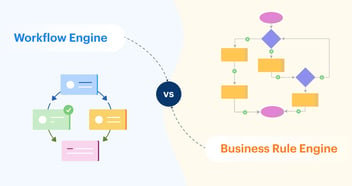
- >
- Workflow Platform >
- 10 Benefits of Workflow Management System Can Boost Your Business in 2025
10 Benefits of Workflow Management System Can Boost Your Business in 2025
Think about how work happens in your team. You have a solid plan for your project, but is it always smooth and peaceful? Probably not. Someone initiates a task or approval and then follows a long road of confusion and chaos lurking around each corner.
The only fix that can eliminate chaos and get to your goals faster is to streamline all your tasks in a workflow. Good workflow management helps you get there. When you build, automate, and manage workflows effectively, you understand the whole picture with each and every step clearly.
One of the key benefits of workflow automation is that it helps eliminate bottlenecks, reduce manual errors, and improve overall efficiency. Workflow management systems help you streamline workflows and make processes easier.
What does a workflow management system do?
A workflow management system designs, creates, and executes workflows. It monitors and manages people, processes, and machines involved in the day-to-day business processes of an organization.
It organizes and prioritizes the steps involved in executing workflows. It can also troubleshoot workflows and adjust dysfunctional steps based on specific conditions.
Mapping out processes with a workflow management system provides a top-level view of the business. It can also serve as a centralized source of truth for documenting and enforcing workflow requirements, keeping all stakeholders on the same page. The workflow management system can also generate workflow reports for enterprises.
Elements of a good workflow management system
A well-defined workflow management system brings more structure to business processes. However, not all of them can achieve this. A poorly designed workflow management system can end up hindering growth and productivity. That’s why understanding the importance of workflow automation is crucial to ensuring efficiency and seamless operations. Maximizing the benefits of a workflow management system becomes easier when organizations adopt the right business workflow tool to streamline operations and improve efficiency.
4 main elements of a good workflow management system are:
1. Transparency
A workflow management system collects data related to business processes and ensures that all stakeholders can access the same information at any time. It gives everyone a clear view of internal processes, enabling them to identify where action is required.
2. Visibility
A workflow management system improves visibility by providing a centralized platform where all processes and tasks are documented. Team members and decision-makers can track workflows and the status of every task in real-time.
3. Accountability
Improved visibility into every task assignment and detailed audit trails documenting every step of a workflow increase accountability across the board. A good workflow management system makes monitoring how employees meet their deadlines and contribute to the workflow easier.
4. Compliance
A good workflow management system standardizes processes, conducts audit trails, automates compliance checks, and helps organizations establish a robust compliance framework.
Learn more: Custom workflow software
10 benefits of workflow management system
1. Reduced errors
Operating with zero errors is impossible. But being proactive in identifying and setting errors right is something you can work on. With workflow management systems, it is easier to prevent errors from occurring in the first place. And if they happen, your system pinpoints the exact location. Understanding the importance of workflow automation ensures you can work out the kinks and prevent the same errors from happening again.
2. Improved connectivity
Workflow management systems connect multiple entities–people, software, and work culture. Employees have communication tools to connect with each other. But what about their work? Work should be equally well-connected to enable high productivity.
Integration between software systems is critical in IT infrastructure. A workflow system draws data from different software tools and runs workflows between them. Most tasks need employees to use more than one application. Workflow systems function as facilitators that pass the baton.
Data on how work happens is slowly pooled in a workflow management system as you use it more and more. You can use the data to improve workflows. Prevent errors and build stronger connections between people and software.
The only robust workflow tool that scales with your business
3. Increased productivity
Employees feel the difference before and after you implement a workflow management system. Since all workflows are automated, teams save a lot of time sending emails and updating information in multiple tools. Why workflow is important becomes evident when employees don’t need to wait with crossed fingers for approvals to reach them. They can track the progress in the workflow system and stay in the loop.
Are critical data missing in an approval? Employees can send it back to someone in the previous step of the workflow and even communicate contextually within the tool. Information is not stuck in a heap of out-of-context emails. Everything happens quickly and smoothly.
4. Redundant manual tasks eliminated
According to this study, repetitive tasks cost $5 trillion a year globally. Office workers spend an average of 69 days per year on mundane tasks. Imagine the amount of productive time you gain if that time is spent doing other tasks that need human attention.
With workflow systems, pre-defined business rules do the job for you. Configure the system to trigger steps based on conditions to automatically delegate tasks. For example, if you have a budget approval at hand, you can map the workflow for approvals to reach the right job roles.
Go from chaos to convenience: The simplest workflow tool ever
5. Multiple tasks juggled easily
Whether you want to onboard multiple employees, manage IT requests, run internal surveys, raise marketing content requests, or approve travel reimbursements, everything is under one roof.
Workflow automation benefits ensure that requests are neatly organized according to different processes in one workflow system instead of multiple project boards, chat tools, and emails. You can switch between a purchase request and a travel reimbursement request in the same tab. No confusion, no delays.
6. Increased trust, transparency, and control
Micromanagement is greatly reduced. The duties of each job role are crystal clear with defined goals. Employees are informed on what they need to do, managers are comfortable delegating ownership over tasks.
Workflow automation squeezes out shadow tasks. Everything happens out in the open, with more control over data accessibility than before. Admins can choose to display or hold back sensitive information to specific job roles or teams.
7. Improved work culture
With many companies working remotely, there’s already enough emails and messages going around. A workflow tool helps keep work organized and trackable. Employees are more collaborative and goal-driven.
Workflow management has the potential to evolve into a company-wide practice that gets engraved in a company’s work culture. When everyone is sold to the idea of structured and streamlined processes, you meet your business goals faster.
8. Create better strategies
Crafting strategies is easier when you have a clear overview of all your workflows. A workflow management system does more than just define your business processes. You also gain insights into performance levels, allowing you to figure out areas of improvement quickly.
9. Identify weak spots
Inefficient workflows can crop up due to redundant steps, poor process ownership, and lack of transparency. These weak spots can pile up quickly, hindering productivity and performance. A workflow management system can identify and eliminate these weak spots, improving efficiency and boosting business value.
10. Elevate customer experience
The key to elevating customer experience is mapping out well-defined workflows for streamlining internal processes.
The importance of workflow automation lies in its ability to eliminate inconsistencies or errors to a large extent. Even when errors occur, having a streamlined process for responding to customer complaints or queries improves the promptness and quality of customer service.
Explore the numerous benefits of using workflow software for business process management.
When to upgrade your workflow management system
A workflow management system should evolve alongside business needs. Upgrade delays can lead to inefficiencies, security risks, and reduced productivity. Managing IT operations efficiently is key for IT Leaders, IT Managers, and IT Teams. A low-code platform simplifies enterprise app development and process automation. Here are key signs that it’s time for an upgrade:
-
Growing process complexity: If existing workflows require excessive manual intervention, custom scripts, or workarounds, a more advanced system with automation capabilities is necessary.
-
Integration challenges: Legacy systems often struggle to connect with modern business applications. Upgrading to a platform with built-in integrations simplifies data exchange and reduces IT dependency.
-
Limited scalability: If your current system cannot handle increased workload demands or multi-department collaboration, a more flexible, cloud-based solution can provide scalability.
-
Poor user adoption: A system that is difficult to use leads to low engagement. Upgrading to an intuitive, no-code/low-code platform makes workflow automation accessible to more teams.
-
Compliance and security risks: Outdated systems may not align with the latest security protocols or regulatory requirements. A modern solution ensures compliance while safeguarding sensitive data.
Try automating that frustrating process

Kissflow is a low-code platform that allows you to transform complex business processes into streamlined workflows with minimal to no coding. The advantages of workflow automation become evident with its drag-and-drop visual editor, enabling business users to create workflows in just a few clicks.
With a centralized platform for workflow management, you can digitize and integrate workflows across the organization, improving transparency, accountability, and collaboration. Process Owners, Process Heads, and Process Managers must ensure smooth and efficient workflows. Automating processes with a low-code platform enhances agility and accuracy. Discover how Kissflow helps process owners.
Solve your workflow challenges with Kissflow and optimize your team's productivity.
Kissflow Workflow transforms the way you get work done
FAQ
1. What are the benefits of a workflow management system?
A workflow management system improves efficiency, reduces manual errors, and enhances collaboration by automating repetitive tasks. It provides better visibility into processes, ensures accountability, and accelerates decision-making, leading to increased productivity and streamlined operations.
2. What is the purpose of workflow management?
The purpose of workflow management is to organize, optimize, and automate business processes to ensure smooth task execution. It helps teams track progress, eliminate bottlenecks, and maintain consistency, ultimately improving operational efficiency and business agility.
3. What is workflow and why is it important?
A workflow is a series of tasks or steps that need to be completed to achieve a specific outcome. It is important because it standardizes processes, improves coordination among teams, and ensures that tasks are completed efficiently without unnecessary delays or errors.
4. What is the most important aspect of workflow management?
The most important aspect of workflow management is process automation. Automating workflows minimizes human intervention, reduces errors, and speeds up task completion, leading to greater efficiency and improved overall business performance.
5. How does a workflow management system improve efficiency?
A workflow management system improves efficiency by standardizing processes for consistent execution, automating routine tasks and handoffs, providing real-time visibility into process status, identifying bottlenecks through performance analytics, ensuring compliance with business rules, facilitating collaboration across departments, and enabling continuous improvement through performance data.
6. What industries benefit most from workflow automation?
Industries benefiting most from workflow automation include financial services (loan processing, claims handling), healthcare (patient scheduling, insurance verification), legal services (contract management, case processing), manufacturing (quality assurance, maintenance workflows), and government agencies (permit applications, citizen service requests).
7. What are the top workflow management tools?
Top workflow management tools offer visual process designers for non-technical users, robust integration capabilities with existing systems, mobile accessibility for on-the-go approvals, real-time analytics dashboards, flexible automation options, role-based access controls, document management capabilities, and cloud-based deployment with enterprise security. The best platforms combine ease-of-use with sophisticated capabilities.
8. How do businesses measure workflow performance?
Businesses measure workflow performance through cycle time (end-to-end duration), throughput (volume handled per time period), error rates, resource utilization, cost per transaction, exception handling frequency, and customer/employee satisfaction. Advanced organizations also track process compliance, automation rates, and value-added time versus wait time throughout workflows.
9. What are the challenges in implementing workflow management?
Challenges in implementing workflow management include integration difficulties with legacy systems, resistance to change from employees comfortable with existing processes, difficulty capturing exception handling for edge cases, inadequate user training leading to workarounds, underestimating process complexity during design, data quality issues undermining automation effectiveness, and failing to redesign processes before automating them.
Related Articles












